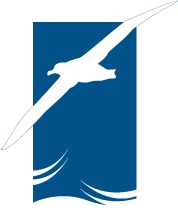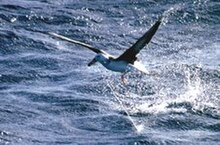Agreement on the Conservation of Albatrosses and Petrels
 Logo of the Conservation of Albatrosses and Petrels | |
| Abbreviation | ACAP |
|---|---|
| Formation | 1 February 2004 |
| Type | International organization |
| Purpose | Conservation |
| Location | |
| Coordinates | 42°53′00″S 147°19′37″E / 42.8833029°S 147.3268095°E |
Area served | International |
Membership | 13 state members |
Executive Secretary | Marco Favero |
| Website | acap |

The Agreement on the Conservation of Albatrosses and Petrels (ACAP) is a legally binding international treaty signed in 2001 and entered into force on 1 February 2004 when South Africa ratified as the fifth Party to the agreement.
It was created in order to halt the drastic decline of seabird populations in the Southern Hemisphere, particularly albatrosses and petrels procellariids. Albatrosses and petrels are threatened by introduced species on their breeding islands, pollution, and being taken as bycatch by longline fisheries, as well as by trawl and gillnet fisheries. The agreement requires that measures be taken by signatory governments to reduce bycatch; protect breeding colonies; and control and remove introduced species from breeding sites, especially on islands.
Currently, ACAP protects all the world's albatross species, seven Southern Hemisphere petrel and two shearwater species. The agreement marks an increasing international commitment to protect albatrosses and petrels.
Organization
The Executive Secretary of ACAP is Marco Favero, who is supported by a Science Officer, Wiesława Misiak, and an Information Officer, John Cooper.[1] The secretariat is located at 119 Macquarie Street, Hobart in the state of Tasmania, Australia.[2][3]
The agreement entered into force on 1 February 2004. National representatives of the signatory countries meet regularly.
| Location | Date |
|---|---|
| Hobart, Australia | 10-12 November 2004 |
| Christchurch, New Zealand | 13-17 November 2006 |
| Bergen, Norway | 27 April - 1 May 2009 |
| Lima, Peru | 23-27 April 2012 |
| Santa Cruz de Tenerife, Spain | 4-8 May 2015 |
Nine meetings of ACAP's Advisory Committee have been held to date, the last in La Serena, Chile from 9 to 13 May 2016. The Advisory Committee is currently supported by three working groups for Taxonomy, Seabird Bycatch, and Population and Conservation Status.
Provisions
ACAP helps countries to implement species action plans, control the expansion of non-native predators, introduce measures reducing bycatch of seabirds, and support research in the sphere of the effective conservation of petrels and albatrosses. To this end it has published ACAP Species Assessments, booklets, mitigation factsheets, and a number of ACAP Conservation Guidelines, including for biosecurity; eradication of introduced mammals; translocation; and census and survey methods.
One of the agreement's main activities is to provide expert advice on seabird bycatch mitigation to fisheries managers, both in domestic and high seas fisheries.
Species covered by the Agreement
The following 31 species of albatrosses, petrels and shearwaters are listed by the agreement.
List of albatrosses covered by the agreement:
- Northern Royal Albatross (Diomedea sanfordi)
- Southern Royal Albatross (Diomedea epomophora)
- Wandering Albatross (Diomedea exulans)
- Antipodean Albatross (Diomedea antipodensis)
- Amsterdam Albatross (Diomedea amsterdamensis)
- Tristan Albatross (Diomedea dabbenena)
- Sooty Albatross (Phoebetria fusca)
- Light-mantled Albatross (Phoebetria palpebrata)
- Waved Albatross (Phoebastria irrorata)
- Short-tailed Albatross (Phoebastria albatrus)
- Laysan Albatross (Phoebastria immutabilis)
- Black-footed Albatross (Phoebastria nigripes)
- Atlantic Yellow-nosed Albatross (Thalassarche chlororhynchos)
- Indian Yellow-nosed Albatross (Thalassarche carteri)
- Grey-headed Albatross (Thalassarche chrysostoma)
- Black-browed Albatross (Thalassarche melanophris)
- Campbell Albatross (Thalassarche impavida)
- Buller's Albatross (Thalassarche bulleri)
- Shy Albatross (Thalassarche cauta)
- White-capped Albatross (Thalassarche steadi)
- Chatham Albatross (Thalassarche eremita)
- Salvin's Albatross (Thalassarche salvini)
List of petrels and shearwaters covered by the agreement:
- Southern Giant Petrel (Macronectes giganteus)
- Northern Giant Petrel (Macronectes halli)
- White-chinned Petrel (Procellaria aequinoctialis)
- Spectacled Petrel (Procellaria conspicillata)
- Black Petrel (Procellaria parkinsoni)
- Westland Petrel (Procellaria westlandica)
- Grey Petrel (Procellaria cinerea)
- Balearic Shearwater (Puffinus mauretanicus)
- Pink-footed Shearwater (Puffinus (Ardenna) creatopus)
Member states
The following 13 countries are parties to the agreement:
 Argentina
Argentina Australia
Australia Brazil
Brazil Chile
Chile Ecuador
Ecuador France
France New Zealand
New Zealand Norway
Norway Peru
Peru South Africa
South Africa Spain
Spain United Kingdom
United Kingdom Uruguay
Uruguay
Canada, Namibia, and the United States regularly send observer delegations to ACAP meetings, but have not as yet acceded to the agreement.[4] Japan has sent delegations in some years.
See also
References
- ^ "Agreement on the Conservation of Albatrosses and Petrels - ACAP Secretariat Staff". acap.aq. Retrieved 30 June 2017.
- ^ "Headquarters Agreement Between the Government of Australia and the Secretariat to the Agreement on the Conservation of Albatrosses and Petrels (Hobart, 23 June 2008) - ATS 19 of 2008”. Australasian Legal Information Institute, Australian Treaties Library. Retrieved on 18 April 2017.
- ^ "Agreement on the Conservation of Albatrosses and Petrels - Home". acap.aq. Retrieved 30 June 2017.
- ^ Williams, Ted (May 2016). "How Congress Can Protect Seabirds With One Simple Act". Audubon. Retrieved May 17, 2016.
External links
- Convention on the Conservation of Migratory Species of Wild Animals
- Procellariiformes
- Albatrosses
- Treaties concluded in 2001
- Treaties entered into force in 2004
- Bird conservation
- 2004 in the environment
- Treaties of Argentina
- Treaties of Australia
- Treaties of Brazil
- Treaties of Chile
- Treaties of Ecuador
- Treaties of France
- Treaties of New Zealand
- Treaties of Norway
- Treaties of Peru
- Treaties of South Africa
- Treaties of Spain
- Treaties of the United Kingdom
- Treaties of Uruguay
- Intergovernmental organizations established by treaty
- International organisations based in Argentina
